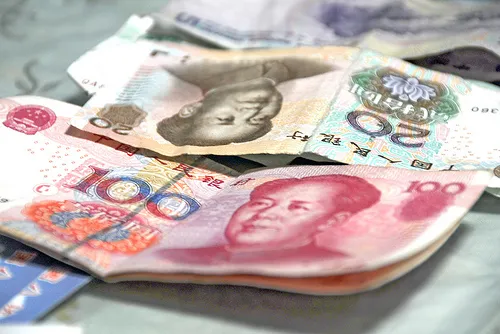
Here are the 4 trends that will dictate RMB movement
One is less Chinese government intervention.
According to OCBC, there are four notable changing factors that drive RMB movement in the context of China’s currency reform and capital account liberalization, including 1) RMB is much closer to its equilibrium level, 2) The Chinese government has shown less appetite to intervene the currency market, 3) Chinese corporate and residents have shown more willingness to hold foreign currency and 4) Cross border flows have become more unpredictable and volatile.
Here's more from OCBC:
China’s current account surplus as percentage of GDP has narrowed significantly to 2.6% in 2012 from 10.1% in 2007. Meanwhile, China’s financial and capital account flipped to a deficit in 2012, the first time since Asian crisis. The latest data from the BIS showed that RMB effective exchange rate has already hit its record high in real term. As such, based on China’s balance of payment position and the RMB’s effective exchange rate value, we think RMB is much closer to its equilibrium level than before.
The Chinese government has shown less appetite to intervene its currency market since April 2012 when the central bank widened the RMB’s daily trading band to 1% from 0.5%.
The deregulation in foreign exchange market has allowed Chinese corporate to retain more export proceeds in foreign currency. Chinese foreign currency deposits held by both corporate and residents rose significantly in 2012, which is a sign of their increasing willingness to hold foreign currency denominated assets.
The cross border flow has also become more unpredictable given that there have been more triggers behind the flows amid the process of capital account liberalization.
Moving forwards, the cross border flows could be more sensitive to the interest rate and currency change in both onshore and offshore markets during the process of China’s capital account liberalization. Factors, such as the divergence between USDCNY and USDCNH and changing funding costs in onshore and offshore market, may lead to the change in supply and demand for RMB.
On China’s capital account liberalization, it is becoming more challenging for policy makers to manage China’s capital account given heightening onshore-offshore arbitrage activities taking advantage of price difference (interest rate and currency). China’s currency regulator has been aware of that. The regulators mentioned clearly in its latest report that China will increase its tolerance for capital flows instead of simply tightening their control, which signals that China will continue its path of capital account opening.
Given the RMB is not far from its equilibrium level, a 3-5% gradual appreciation pace per annum is unlikely going forwards. However, this does not mean the end of the RMB appreciation story.
Bottom line: We expect RMB to appreciate against the US dollar by 1-2% in 2013 on the back of improving Chinese economy, rising interests in Yuan-denominated assets and broad dollar weakness trend. Nevertheless, the appreciation is likely to be with two-way movements rather than the previous one-way gradual movement



![SBR 5 Lorem Ipsum News 2 [8 May]](https://cmg-qa.s3.ap-southeast-1.amazonaws.com/s3fs-public/styles/exclusive_featured_article/public/2025-05/a_hand_pointing_to_a_futuristic_technology_5b87c9d0e3_3.png.webp?itok=M3Hf-9XR)
![SBR 4 Lorem Ipsum [8 May Top Stories]](https://cmg-qa.s3.ap-southeast-1.amazonaws.com/s3fs-public/styles/exclusive_featured_article/public/2025-05/a_hand_pointing_to_a_futuristic_technology_5b87c9d0e3_2.png.webp?itok=2m5Wl0MX)


![Exclusive three SBR 12 Lorem Ipsum [8 May]](https://cmg-qa.s3.ap-southeast-1.amazonaws.com/s3fs-public/styles/exclusive_featured_article/public/2025-05/a_hand_pointing_to_a_futuristic_technology_5b87c9d0e3_11.png.webp?itok=8kn_UIfA)
![SBR 3 Lorem Ipsum [ Exclusive 2]](https://cmg-qa.s3.ap-southeast-1.amazonaws.com/s3fs-public/styles/exclusive_featured_article/public/2025-05/a_hand_pointing_to_a_futuristic_technology_5b87c9d0e3_1.png.webp?itok=YCyjLegJ)
![SBR 2 Lorem Ipsum [8 May]](https://cmg-qa.s3.ap-southeast-1.amazonaws.com/s3fs-public/styles/exclusive_featured_article/public/2025-05/a_hand_pointing_to_a_futuristic_technology_5b87c9d0e3_0.png.webp?itok=_cKD-29o)

![Video [Event News]](https://cmg-qa.s3.ap-southeast-1.amazonaws.com/s3fs-public/styles/event_news_featured_article/public/2025-05/screenshot-2025-05-08-at-4.58.53-pm_0.png.webp?itok=Kud35sMs)
![Event News SBR 9 Lorem Ipsum [8 may]](https://cmg-qa.s3.ap-southeast-1.amazonaws.com/s3fs-public/styles/event_news_thumbnail/public/2025-05/a_hand_pointing_to_a_futuristic_technology_5b87c9d0e3_8.png.webp?itok=DTh_dbYp)
![Event News SBR 9 Lorem Ipsum [8 May]](https://cmg-qa.s3.ap-southeast-1.amazonaws.com/s3fs-public/styles/event_news_thumbnail/public/2025-05/a_hand_pointing_to_a_futuristic_technology_5b87c9d0e3_7.png.webp?itok=vzDAzb6V)
![Event News SBR 8 Lorem Ipsum [8 May]](https://cmg-qa.s3.ap-southeast-1.amazonaws.com/s3fs-public/styles/event_news_thumbnail/public/2025-05/a_hand_pointing_to_a_futuristic_technology_5b87c9d0e3_6.png.webp?itok=jvHFc4P6)
![Video [Event News]](https://cmg-qa.s3.ap-southeast-1.amazonaws.com/s3fs-public/styles/video_thumbnail/public/2025-05/screenshot-2025-05-08-at-4.58.53-pm_0.png.webp?itok=yZnI0YBb)
![Video 1 SBR [8 May]](https://cmg-qa.s3.ap-southeast-1.amazonaws.com/s3fs-public/styles/video_thumbnail/public/2025-05/screenshot-2025-05-08-at-4.58.53-pm.png.webp?itok=9AAeRz_k)

 Advertise
Advertise

